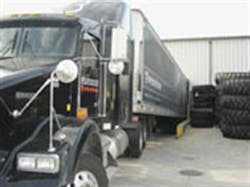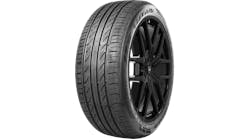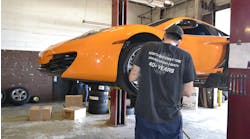This article by commercial tire sales expert Jason Miller is the second installment in a multi-part series about how to land and keep commercial truck tire accounts. In the February 2008 edition of Commercial Tire Dealer, Miller discussed how to break the ice with potential customers. In this installment, he talks about what to do once you get your foot in the door. Miller’s book, “Selling by the Numbers,” is available through on-line booksellers, including Amazon.com. For more information about Miller’s company, The Tire Consultants (formerly Miller Business to Business), see www.thetireconsultants.com. Miller can be reached at [email protected].
If you’re like most tire salespeople, once you get your foot in the door, you start telling prospective customers about your company, your products and yourself. In other words, you start by selling, which is the wrong thing to do.
To your prospect, letting you into the office so you can try to sell them tires is like sitting in a dentist chair while the dentist tries to sell you on a good, old-fashioned tooth drilling -- it’s just not something people want to buy! Let’s look at how a typical dentist operates. His first “sale” is just a check-up — quick, noninvasive and relatively painless. There may be a series of X-rays followed by an inspection of your teeth. When he completes his inspection, he looks at the X-rays, which he compares to any problem he may have found. He’s now ready to propose solutions. Great tire salespeople use a similar process. Instead of X-rays and tiny mirrors, they use air and tread depth gauges to perform fleet surveys and scrap tire analysis.
And like your dentist, they do not try to sell solutions until they have thoroughly examined and diagnosed problems.
Here are a few real-life examples of how the process works in the commercial tire world.
[PAGEBREAK]
Mass confusion. I was working on a large regional fleet in the Midwest. The buyer was a loyal, conservative type of guy who didn’t like to switch brands or suppliers — in other words, my favorite kind of customer.
On my first visit, I asked what tire brands he preferred. He told me he bought 60% of Brand A and 40% of Brand B. I asked, “Can I have your permission to visit your terminals and look at your tires just to get to know your fleet a little better?” He agreed and so began my reconnaissance.
After inspecting trucks at nine different terminals, I found every brand you can think of in operation within his fleet. I also found numerous flat tires and some that were only inflated to 78 psi!
On my next visit, I asked him to play a game with me. I asked him to name any brand he could think of, and I’d tell him where in his fleet he could find it. He called out Michelin, Firestone, Kumho, Dunlop, Cooper and many, many more. In actuality, less than 40% of his wheel positions were running Brand A and Brand B.
I then asked him what his inflation spec was. One hundred psi was the resounding answer! I asked what he thought his average inflation pressure was. He was surprised to hear the real number. Obviously, this fleet had a maintenance problem. I also discovered at least half of its tires were failing on the highway.
I asked him what percentage of his tire budget was spent on emergency road service. He did not know. He told me that emergency road service calls went directly to his boss.
“Let me get this straight,” I said. “Every time a truck has a problem on the road, your boss gets a call from the driver?”
Yes, he said.
I then asked, “So 50% to 60% of your tires are being replaced on an emergency basis?”
I didn’t have to ask any more questions; he was now seeking solutions, which I helped him define and implement. If I had simply asked, “What brand of tires do you run?” or “How is your maintenance?” do you think I would’ve made any progress?
[PAGEBREAK]
Prescription without diagnosis? This time around, I was working with a tire salesman in the southwestern desert. He told me he had test tires running in a fleet and asked me to go with him to see how they were doing. I arrived at the fleet an hour before he did, just to look around. Trucks had just started to come back for the night. Each driver parked, got out of his truck and used a “calibrated hammer handle” to check air pressures. It’s sweltering, dusty, noisy and each driver is spending 38 seconds walking around their trucks thumping tires!
Through a cloud of dust I see a man walking toward me. He asks if I’m a tire man, to which I respond, “Yes, I am.”
“Great,” he replies. “Can you tell me why my tires are popping?”
I told him I had some ideas but would know more following an inspection. I found that this fleet, like the fleet in the Midwest, was using nearly every brand you could imagine. However, it had some serious problems: air pressures ranged from 70 psi to 130 psi and only some tires mated to each other. I even saw new tires with 26/32-inch tread depth mated on duals right next to worn-down tires!
The scariest part of this story is that the salesman I was working with genuinely believed this was a “test fleet” because the trucking company was “testing” so many different tires, hoping to find one that wouldn’t pop.
Unfortunately, the salesman with whom I was working never made it very far in his conversation with the fleet’s tire buyer. He simply walked in one day (in the middle of the day, when no trucks were even on the lot) and asked the buyer to give his tires a try. The buyer, frustrated that nothing seemed to be working, figured, “What the heck?”
This scenario is far too common. You get your foot in the door and meet a fleet buyer. The buyer, who is scrambling to solve a problem, agrees to give you a shot since nothing else seems to be working. You sell a few tires and stop back from time to time, hoping to sell more. But your new customer isn’t overwhelmed and his enthusiasm fades. What just happened is clear: you offered a solution without properly diagnosing the problem.
[PAGEBREAK]
Tire (and anger) management. Here’s one of my favorites. I stopped to make a call on a large fleet in Texas. When I introduced myself to the buyer, he launched into the longest string of obscenities I had ever heard. (I later learned this was normal behavior. He was known as one of the toughest guys in town to do business with.)
While lambasting me, he exclaimed, “I’ve had nothing but problems with your tires!” Apparently there were irregular wear problems with our steer tires. At the end of his tirade, I courteously asked, “What would you like me to do, sir: help or go away?”
He replied, “I couldn’t care less what you do!”
Well, one of the advantages of having been in this business for so long is that you can’t hurt my feelings!
I politely asked when his trucks would be in so I could take a look just to see if there was anything I could do. He told me the trucks would start rolling in at 7 p.m. and leave the next day at 7 a.m.
I arrived early the next morning to find 60 trucks in the yard, 22 of which were running on my tires. Only three out of 44 showed signs of the irregular wear he had described. The rest of the tires looked great. What struck me as peculiar was that all of our steer tires had at least 13/32-inch or more remaining and that all of the trucks had well over 100,000 miles on them. This was more of a success story than a wear problem.
When the buyer arrived, I asked him to tell me about his current steer tire program. He explained he had tried every premium steer tire he could think of, only to get irregular wear and pull them before 100,000 miles, so he started buying tires with shallow treads. They still had to be pulled at 90,000 miles, but they wore more evenly and cost a lot less, he told me.
Nobody had ever taken the time to show him that in spite of the irregular wear on a few tires, our tires were dramatically outwearing his other steer tires.
I showed him the irregular wear condition that I found in order to confirm that we were talking about the same thing, and we were.
I then agreed to offer a policy concession on the three tires that showed irregular wear. We then reviewed my other findings: only three out of 44 tires had a mild irregular wear pattern and the buyer could not remember any steer tire lasting beyond 100,000 miles.
When we summarized the findings together, it became clear that he was not having a problem with my product.
What I found incredible is that nobody had taken the time to check it out and bring this to his attention! By the end of the meeting, the buyer said to me, “I guess I should switch my fleet over to your tire!”
“Well, if you insist,” I said.
[PAGEBREAK]
These scenarios have one thing in common: once the buyer lets me in, I do not try to sell tires. I try to learn as much as I can about the fleet, identify problems and find a way to make it better.
Like many salespeople, I still hear buyers telling me they’re in “pretty good” shape and can’t think of anything that can be improved. But there’s always something that can be improved.
The trucking business is so competitive that any fleet that isn’t doing at least 95% of the things it should will soon be out of business. The key is to be that one person in your market who can find and fix the remaining 5%.
Don’t settle for ‘good enough’ -- Tips on selling to fleets
“As I reflect on my fleet selling accomplishments, here are a few observations,” says Jason Miller:
• Effective fleet tire selling is a technical process. If you’re not a technical expert, become one.
• My greatest opportunities presented themselves before or after normal business hours. Working 8 to 5 is for the mediocre majority; tire selling champions are working when their competitor is still in bed or at home watching TV.
• If you want long-term business, you must be willing to get dirty.
• The meaner the customer, the fewer competitors you’ll have to worry about. Don’t take the hostility personally. It’s not directed at you as a person; it’s directed to the position you hold and the roles both of you are playing.
• Never propose a solution until you have accurately diagnosed a problem. If your doctor did that, he or she could be held liable for malpractice.
“Every fleet has challenges that a determined, trained professional can fix, given the opportunity,” says Miller. “’Good enough’ rarely is.”
In the June edition of CTD, Miller looks at how to build a case for change so you can begin the selling process.




